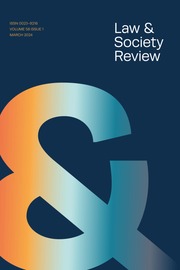Article contents
A Neo-Institutional Account of Prison Diffusion
Published online by Cambridge University Press: 01 January 2024
Abstract
Interest in legal innovations, particularly in the criminal law realm, often centers on an innovation's emergence, but not its subsequent diffusion. Typifying this trend, existing accounts of the prison's historical roots persuasively explain the prison's “birth” in Jacksonian-Era northern coastal cities, but not its subsequent rapid, widespread, and homogenous diffusion across a culturally, politically, and economically diverse terrain. Instead, this study offers a neo-institutional account of the prison's diffusion, emphasizing the importance of national, field-level pressures rather than local, contextual factors. This study distinguishes between the prison's innovation and early adoption, which can be explained by the need to replace earlier proto-prisons, and its subsequent adoption, particularly in the South and frontier states, which was driven by the desire to conform to increasingly widespread practices. This study further attributes the isomorphic nature of the diffusion to institutional pressures, including uncertainty surrounding the new technology, pseudoprofessional penal reformers and their claims about competing models of confinement, and contingent historical factors that reinforced these institutional pressures. This study illustrates the importance of distinguishing between the motivations that initiate criminal law innovations and those that advance their diffusion.
- Type
- Penal Law & Society
- Information
- Copyright
- © 2015 Law and Society Association.
Footnotes
This research was supported by a Berkeley Empirical Legal Studies Fellowship (2011–2012), a Jurisprudence and Social Policy Dissertation Grant (2012), and a Library Resident Research Fellowship at the American Philosophical Society Library (2011–2012). The author would like to thank Nora Lambrecht for her assistance in compiling the statutes for this project and UC Berkeley's Undergraduate Research Apprenticeship Program, which sponsored her work. The author would also like to thank Eric Baumer, Tom Blomberg, Ted Chiricos, Miltonette Craig, Lauren Edelman, Malcolm Feeley, Cybelle Fox, Johann Koehler, Calvin Morrill, Deana Rohlinger, Jonathan Simon, and Stephen Tillotson for reading and commenting on multiple drafts of this article. Finally, the author would like to thank the editors and the anonymous reviewers for their very helpful feedback. Any errors remain my own.
References
- 45
- Cited by


